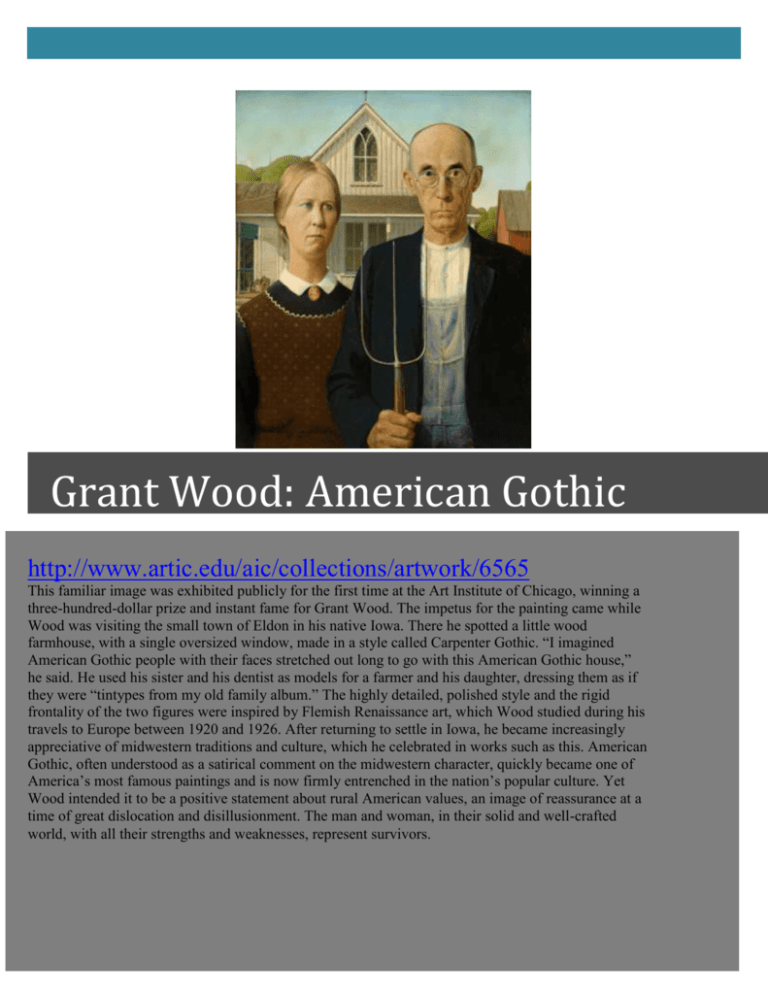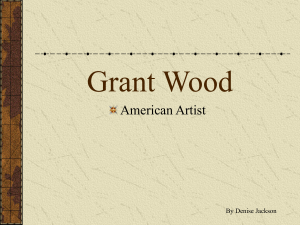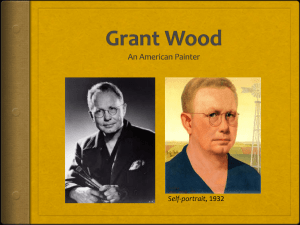Grant Wood - TeacherWeb
advertisement

Grant Wood: American Gothic http://www.artic.edu/aic/collections/artwork/6565 This familiar image was exhibited publicly for the first time at the Art Institute of Chicago, winning a three-hundred-dollar prize and instant fame for Grant Wood. The impetus for the painting came while Wood was visiting the small town of Eldon in his native Iowa. There he spotted a little wood farmhouse, with a single oversized window, made in a style called Carpenter Gothic. “I imagined American Gothic people with their faces stretched out long to go with this American Gothic house,” he said. He used his sister and his dentist as models for a farmer and his daughter, dressing them as if they were “tintypes from my old family album.” The highly detailed, polished style and the rigid frontality of the two figures were inspired by Flemish Renaissance art, which Wood studied during his travels to Europe between 1920 and 1926. After returning to settle in Iowa, he became increasingly appreciative of midwestern traditions and culture, which he celebrated in works such as this. American Gothic, often understood as a satirical comment on the midwestern character, quickly became one of America’s most famous paintings and is now firmly entrenched in the nation’s popular culture. Yet Wood intended it to be a positive statement about rural American values, an image of reassurance at a time of great dislocation and disillusionment. The man and woman, in their solid and well-crafted world, with all their strengths and weaknesses, represent survivors. Image One Wood, the Midnight Run of Paul Revere, 1931, Oil on Masonite In The Midnight Ride of Paul Revere, the Midwestern painter Grant Wood casts a magical spell on a familiar American story. As scholar Wanda Corn has recounted, as a child, Wood had been captivated by the tale of Revere’s journey through the night from Boston to Lexington (the site of the opening skirmish of the Revolutionary War) to warn the patriots of the British advance. The precise details of this historical event would have been indistinct, or perhaps unknown, to Wood since, like most Americans of his day, he had learned the legend from a poem by Henry Wadsworth Longfellow, published in 1863: Listen, my children, and you shall hear Of the midnight ride of Paul Revere, On the eighteenth of April in Seventy-five; Hardly a man is now alive Who remembers that famous day and year. Wood was enchanted by the notion of a local hero bearing urgent news, raising the alarm, and consequently attaining immortality. He liked to imagine himself on just such a mission in his home state of Iowa, galloping from farm to farm to warn his neighbors of an impending tornado—“and being handsomely praised when the storm was over and everyone had been saved.” Wood never had the opportunity to become that sort of hero, but he did become immortal through his famous work American Gothic (1930)—painted just a year before he completed The Midnight Ride—which dignifies a homely country couple on an ordinary Iowa farm. Image Two Wood, Young Corn, 1931, Oil on Wood Grant Wood was born on a farm near the small town of Anamosa, in 1891. By painting simple scenes of the land and people he knew best, he helped create an important, allAmerican style of art. Grant Wood’s paintings show the love he had for the people and customs of the Midwestern United States. Grant Wood particularly loved the farmland of Iowa. While growing up, he enjoyed feeling the soft, warm soil between his toes as he walked barefoot through the fields. In his painting Young Corn it seems like the round, friendly hills are protecting the farmer and his children while they work in their fields. Guiding Questions 1) Grant Wood was inspired by the Flemish Renaissance. This artistic style helped him develop a very personal style of painting. Describe American Gothic and mention how the historical art influence is seen in the painting. 2) Why do you think some critics saw his work as humorous and others saw it as a reflection of American idealism? Identify characteristics of his work that would defend both perspectives. PERSONAL CONNECTION: What art style influences your own work - how?







